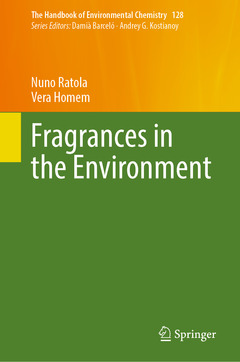Fragrances in the Environment, 2024 The Handbook of Environmental Chemistry Series, Vol. 128
Coordonnateurs : Ratola Nuno, Homem Vera

This book offers a comprehensive and authoritative review of the key environmental areas and compartments where fragrances have been found and discusses the current challenges of their presence and potential hazards. The book starts with a chapter devoted to the manufacturing and characterization of the most relevant types of fragrances, and their emissions to the environment. Subsequent chapters cover topics such as fragrances? toxic effects on the environment, their major routes of exposure, behaviour, and fate in different environmental matrices. Particular attention is given to ecotoxicological issues and the environmental impact of fragrances in wastewater treatment plants, surface waters, marine environments, soils, remote areas, and air. In this book, readers will find valuable insights into the bioaccessibility and availability of synthetic musks in seafood and the corresponding human exposure and health risks. The book also outlines the most promising analytical methods used for fragrance detection and quantification, and it discusses the risks and future trends in this field.
Written by a multidisciplinary team of expert contributors, and considering its scope, this book is an essential tool not only for scholars and researchers in academia and industry but also for other stakeholders and decision-makers interested in the field of fragrances and their ecotoxicology, as well as environmental impacts.
Vera Homem is an Assistant Researcher at the Laboratory for Process Engineering, Environment, Biotechnology and Energy (LEPABE), a research unit at the Faculty of Engineering at the University of Porto (FEUP, Portugal) and an Invited Assistant Professor at FEUP since 2013. She graduated in Chemical Engineering (2007) and holds a PhD in Environmental Engineering (2011) from FEUP. Her research has mainly focused on environmental chemistry, namely the development of new analytical methodologies for the detection of emerging organic contaminants at trace levels in the environment, monitoring strategies, development of risk assessment studies, prioritization systems, remediation technologies (advanced oxidation processes and sorption), soil contamination issues and waste valorisation.
Date de parution : 06-2024
Ouvrage de 299 p.
15.5x23.5 cm



